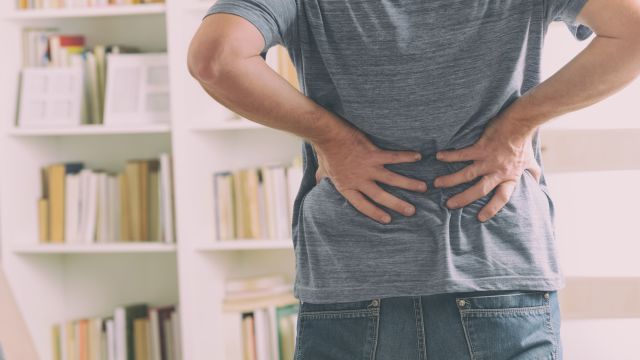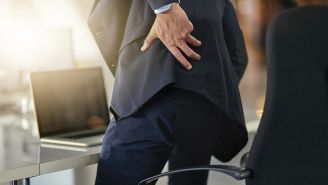Maybe you felt a sharp, shooting pain in your lower back while lifting a laundry basket.
Maybe you experienced muscle spasms a few minutes after a big golf swing. Or maybe nothing happened at all, but you suddenly can't move your torso.
If you're like many Americans, you'll tell people you threw out your back—and they'll know exactly what you're talking about. This kind of pain is familiar to millions, a leading cause of missed work days, and a top reason for visits to healthcare providers (HCPs). But what does the expression really mean?
"It means they have an acute onset of low back pain, in the lumbar region of their spine, just below their ribs and just above their pelvis," says Kimberly Waters, a physical therapist in Charleson, South Carolina. While the exact reason for the injury often goes undiagnosed, "the most likely thing that happens when people throw out their back is a muscle strain—but there are other things that can happen, like a bulging disk or a disk herniation."
Fortunately, throwing your back out is usually a temporary situation, and there are ways to speed recovery and help prevent it from happening again. Here's what you should know.
Who throws out their back?
At least 80 percent of us will experience lower back pain at some point or another. Incidents involving acute pain can happen to anyone, but become increasingly common with age. While people with physically demanding jobs are more prone, office workers who sit for long periods of time with inadequate back support can be affected, too.
Poor physical fitness is another risk factor; those who don't get much activity have higher odds of lower back issues, as do "weekend warriors."
"These are people who are normally sedentary throughout the week, and then on the weekends, they go play golf for a few hours, or go play softball or soccer," says Waters. In this case, the pain is triggered by a brief bout of intense exercise following a longer period of little movement.
And if you've thrown your back out before? You're more likely to do it again. Sometimes, the initial injury is the first indication you're in for a longer struggle; about one in five people who experience acute lower back pain still have chronic pain a year later.
What happens, exactly?
Most often, when someone throws their back out, it's thought to be due a muscle strain, caused by lifting a heavy item or bending the wrong way. "The muscle can tighten up or go into spasm, and the spasm is what causes the pain," says Waters. The pain can vary, from a dull ache to an intense throbbing, but it will likely remain localized around your lumbar spine—the five vertebrae positioned right above your buttocks.
If the pain spreads outward, "further into the lower back, the buttocks or even down the leg," it may indicate a bulging or damaged disc in your spine. Discs are located between the vertebrae and cushion your bones as you move around. When they start to break down, they can compress nerves, resulting in radiating pain.
Very occasionally, acute lower back pain is triggered by something more serious, such as an infection, a broken vertebra, or even cancer. These problems are likelier in people over 50, those who have already had cancer, people on long-term steroids, heavy drug users, and adults with pre-existing medical conditions like diabetes or osteoporosis.
"You'll definitely want to see a doctor if you're having severe back pain and if it happens after a fall, an injury, or a motor vehicle accident," says Waters. Seek immediate medical attention if you experience any of the following emergency symptoms, as well:
- Pain, weakness, or loss of feeling in your legs
- Severe pain that greatly limits your ability to do simple things
- Bladder or bowel control issues
- Weight loss you're unable to explain
- Fever or symptoms of illness
Also, check in with an HCP if your pain doesn't get better after four weeks. Most acute lower back pain subsides in days or a few weeks, so prolonged soreness may indicate something more is wrong.
How to get relief
Usually, the pain caused by throwing your back out goes away on its own, and you won't need to see a medical professional. During recovery, your biggest concerns will likely be easing the soreness and getting back on your feet.
In the first 72 hours following the event, Waters suggests applying ice to ease the pain, and says heating pads may come in handy after the third day. Neither will help your recovery per se, but they may ease your ache in the moment.
Certain over-the-counter (OTC) drugs may help relieve the pain, as well. Acetaminophen is one option, and non-steroidal anti-inflammatory drugs (NSAIDs) like ibuprofen (Advil, Motrin) or naproxen (Aleve) are another. The NSAIDs will also reduce inflammation, which can further ease symptoms, says Waters. Just make sure you speak to an HCP first, since NSAIDs may cause health complications for people with certain conditions or on certain medications. Bonus tip: Instead of popping a pill when the pain is too great, experts suggest OTC drugs generally work better if taken regularly for three to five days.
Remember that moving helps
In the days after you throw your back out, resting up may feel good, but staying moderately active is proven to help with recovery by stimulating blood flow, increasing flexibility, and preventing spasms.
"Find a position of comfort, but then do try to get up and move around," says Waters. "You don't want to lay in bed too long or sit too long, because even after just 24 hours of bed rest, you actually start losing muscle mass."
Walking and light chores are a good way to get moving. Stretching can be useful, as well. "Longer sustained stretches are shown to be more beneficial than more frequent, less holding stretches," adds Waters. She suggests lying in bed, pulling one of your knees toward your chest, holding it for 30 to 60 seconds, and repeating the motion three or four times with each leg: "You should feel just a gentle stretch in your low back or gluteal area." And if it hurts too much? It's okay to stop.
While you're recovering, skip high-impact activities and steer clear of BLT—"bending, lifting, and twisting," says Waters. "You don't want to bend over at your waist to reach down to the floor. You don't want to lift anything too heavy." If you do pick something up, keep your shoulders and hips aligned and don't twist your lower back and spine.
Preventing future incidents
When it comes to keeping your lower back healthy, proper body mechanics are the name of the game. To help stave off sudden injuries, learn good posture, the right way to bend over, and how to lift, push, and pull objects correctly. Physical therapists can help teach you the best techniques; locate one using the Find a Doctor function on the Sharecare app, available on iOS and Android.
Also crucial? Regular physical activity. "Keeping your core and legs strong, keeping your quadriceps strong—those are your lifting muscles," Waters says. When those areas are weak, she adds, you use your spine to lift, opening you up for back pain. Maintaining flexibility is key, as well, since muscle groups can become tighter as you grow older. Almost any age-appropriate exercise can be beneficial, and Waters suggests yoga, Pilates and tai chi.
Ultimately, you can't predict where or when you'll throw your back out—but with a few simple precautions, you can reduce the odds and save yourself a few days of pain.







